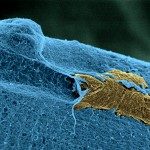Link to Pubmed [PMID] – 22286702
Virulence 2012 Jan-Feb;3(1):43-50
Invasive aspergillosis is a life-threatening disease mainly caused by Aspergillus fumigatus. Patients at risk are generally immunocompromised and lungs are assumed to provide the primary site for infection and invasive disease manifestation. Contrarily, visceral organ involvement appears to result from a subsequent hematogenous spread. To compare the kinetics of dissemination within deep organs in immunosuppressed vs. immunocompetent mice, we used a bioluminescent A. fumigatus strain in an intravenous infection model. By applying an immunosuppressive regimen with corticosteroids, dissemination to the liver and kidneys was observed already 24 h after inoculation accompanied by a marked inflammatory response within the liver. In contrast, in the immunocompetent condition, fungal growth and inflammation were mainly restricted to the kidneys and only small amounts of fungal biomass and a weak inflammatory response were detected in the liver. Additionally, disease progressed much slower compared with the immunosuppressed condition. This is the first study underlying the duality between liver and renal tropism of A. fumigatus in relation to the immune status of the host.



